Celestica is a leader in design, manufacturing and supply chain solutions for the world’s most innovative companies. Here the company details how it is accelerating the global roll-out of drone operations.
Throughout the pandemic, couriers, postal workers and package delivery drivers have often served as a lifeline – bringing much needed goods when we felt shut off from the world.
Today, with interest in online purchases showing no signs of slowing, significant technological advancements and sweeping labour shortages are quickly blazing a trail for a new kind of delivery service – in the form of unmanned aerial vehicles (UAVs) and drones.
Amazon’s announcement that it will soon launch its inaugural drone delivery service in the US is the latest evidence of the global retail industry’s mission to deploy fleets of package delivery drones. McKinsey & Co estimates that more than 2,000 drone deliveries already occur daily worldwide, and projects there will be close to 1.5 million deliveries in 2022. Insider Intelligence predicts the industry will reach 2.4 million total global shipments in 2023 – increasing at a 66.8 per cent compound annual growth rate (CAGR).
Beyond package delivery, commercial UAVs and drones assist emergency workers, deliver life-saving therapies, fly over farms to fertilise crops and monitor livestock, survey building construction sites, and even deliver Girl Scout cookies. In the defence world, drones are used for information, surveillance and reconnaissance that help protect the war fighter in multitudes of mission applications.
The need for speed
The need to build faster, better performing drones and UAVs presents manufacturers with both significant new revenue opportunities and unique challenges.
While they face the same product development hurdles that other aerospace and defence (A&D) OEMs do – supply chain constraints, scaling production and regulatory compliance – drone companies must overcome these challenges in a much shorter timeframe to be competitive. This creates enormous pressure to design and build products right the first time, to avoid costly production and delivery delays or failures in the field.
The Celestica difference
For more than 15 years, Celestica’s depth of technology, engineering expertise, production capability, supply chain solutions, and unrelenting focus on quality have enabled our A&D customers to accelerate their delivery of high-quality products across the globe.
Today, we’re leveraging that industry leadership to speed innovative, high performing UAVs and drones to market – helping our OEM customers in this space to meet the rising demand.
Agile product development
The speed of innovation in drone technology requires proven engineering and product development expertise to help UAV and drone OEMs move quickly from concept, to prototyping to production at scale.
Designing light weight, durable drones while maximising flight time is a key priority. Combining aircraft ruggedised design elements with highly durable composite materials helps reduce drone weight and improve aerodynamics. Leveraging cutting-edge ruggedisation techniques and materials and submitting drones to extensive vibration and stress testing enables safe operation for extended periods in bad weather, heavy winds, and extremes of cold or heat.
Our design for manufacturability approach also prioritises minimising weight while maximising payload capacities. For example, we recently partnered with an innovative US-based motor technology company, ECM, enabling us to design and build remarkably thin, durable, compact, light-weight printed circuit board (PCB) stator motors based on an individual customer’s exact specifications.
Optimised supply chain solutions
UAV and drone OEMs are challenged to deliver their products to market quickly in order to capture opportunity and market share. To ensure success, supply chain challenges such as parts shortages must be swiftly overcome.
Celestica’s global network, purchasing power, and regionalised supply chain model helps our customers proactively manage supply constraints and shorten lead times to meet time-to-market objectives.
Decrease downtime and extend product life
The lifecycle of a drone doesn’t end at production – ongoing support is required to maintain and extend the life of an OEM’s fleet. Commercial-grade drone management ecosystems include charging stations, storage facilities and repair services in proximity to drone deployment areas to minimize downtime and enhance performance. Celestica’s lifecycle management model helps to relieve our customers of the responsibility of conducting long-term product maintenance.
Looking ahead, the drone industry is expanding rapidly – playing an increasingly prominent role in package delivery, surveillance, security, emergency services, agriculture and countless other aspects of day-to-day life. From product development to supply chain optimisation, assembly and after-market support, Celestica is excited to help our growing UAV and drone customers take to the skies.

